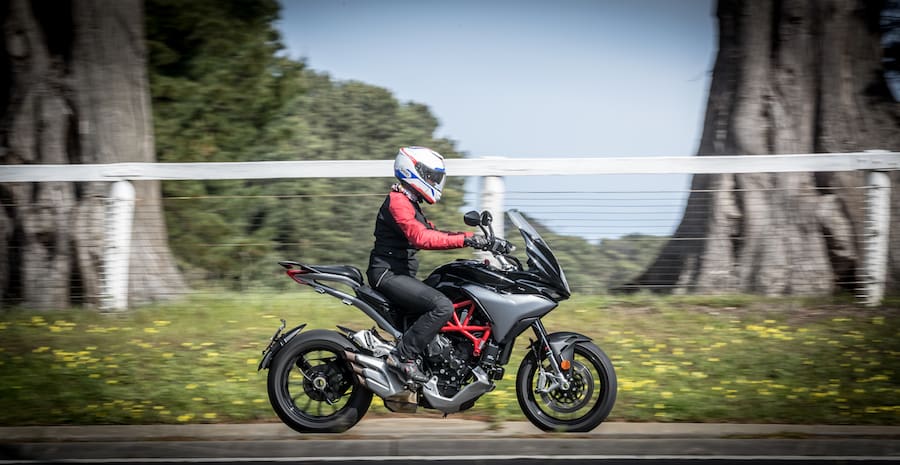Shit,” I cursed as I checked my mirrors and raised my left arm to let the highway-speed traffic behind me know I was in strife. I was out in the far right lane of a three-lane highway and MV Agusta’s Turismo Veloce was missing and spluttering under acceleration, a bevvy of warning lights on the dash alerting me to something of which I was
well and truly aware.
I coasted to the emergency lane and stopped, heart racing, and then I had to laugh. Instead of activating cruise control on the Italian touring bike I’d hopped onto just 10 minutes earlier, I had activated the pitlane speed limiter with its very similar graphic on the bike’s somewhat crowded TFT full-colour five-inch dash.
I took off again, slightly embarrassed, yet secretly loving the fact MV Agusta’s first touring bike comes equipped with a pitlane speed limiter – a delightfully unnecessary nod to the marque’s rich 62-year legacy of racing success. And as I accelerated quickly to merge back among the morning commuters, I realised it can actually be a handy feature on a bike like this, especially in the many highly policed and enforced stretches of roads dotted around this country.

Because of where I live these days, most of my test periods begin with more than an hour of freeway riding that provides a beaut opportunity to get acquainted with a bike before I start asking the hard questions. Mind you, the MV asked a hard question straight up of me, and that’s its 850mm seat height. It’s a long way up, and I certainly am not, but the Turismo Veloce’s waistline is corset-tightened narrow, so once you’ve clambered onto her perch your legs don’t need to go around anything to find their way to the ground. Even for a five-foot-nothing rider like me, there’s plenty of confidence at a standstill.
A thumb of the starter and the recognisable rasp of the Italian-made triple comes alive. The clutch is light – though it matters naught considering how effective the multi-directional quickshifter is – and as I take off I’m reminded of the typical MV Agusta throttle response. The Turismo employs the brand’s MVICS (Motor and Vehicle Integrated Control System) and its ride-by-wire results in one of the lightest-action throttles around. Some have described it as too snatchy, but I really like it.
The upright seating position puts you above every passenger vehicle on the road and, combined with the wide ’bars, it makes picking my way through Melbourne’s morning commuters quite enjoyable.
Once out on the freeway, I’m immediately impressed with the windscreen and the protection it offers, a box every touring bike must tick. It’s a two-position height-adjustable screen with 60mm of variability, and it’s actuated by a clever one-handed doodad so it can be changed on the fly. Importantly, changing the height at highway speeds doesn’t upset the bike and both positions offer an effective windbreak depending on your speed (and height, of course).
As well as the previously mentioned ride-by-wire throttle, or indeed because of it, the MV Agusta has more than enough electronic aids. While there’s no IMU on board – which would facilitate the latest lean-angle-sensitive electrickery like cornering ABS and so forth – the Turismo Veloce boasts switchable ABS, eight levels of traction control (as well as off) and four switchable engine modes: Sport, Touring, Rain and Custom. There’s no electronically adjustable suspension on this version, but its higher-end Lusso sibling offers it.

Melbourne’s wild weather gives me plenty of opportunities to test the different modes in their appropriate environments. And, while I feel I ought to constantly switch as the weather and the conditions change, the wily folk at MV Australia dialled into the Custom setting a mode that they believe showcases the Turismo Veloce at its best. In the end I realise they were exactly right and I leave it in Custom, regardless of the conditions, with the onus back on me to modulate the outcome. Well, not entirely.
The Custom setting unleashes all of the Turismo Veloce’s 81kW of power (in Sport mode), but reduces the severity of the throttle response, which is often half the battle in slippery conditions. Likewise, ABS is set to Level 1 for the least amount of interference, traction control is set to Level 3, just below halfway, and whether I’m splashing around in an inch of water or sailing through warm and dry switchbacks under the sun, the motorcycle itself is so engaging that I am rarely looking for more (or less) in terms of the power, the way it is delivered, or the computer-generated interference out to save my bacon.
Read the full story in the current issue of AMCN (Vol 67 No 10) on sale now












